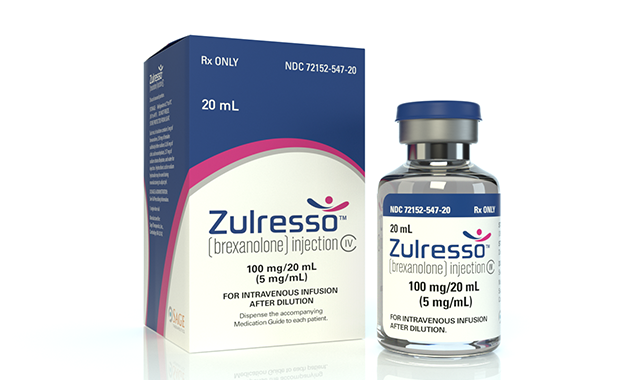New Drug Review: Zulresso (Brexanolone)
The first drug approved to specifically treat post-partum depression.

In March, the FDA approved brexanolone (Zulresso, Sage therapeutics, Inc.) for treatment of postpartum depression in adult women. Brexanolone exerts its effect by modulation of GABAA receptors. It is the first medication approved specifically to treat postpartum depression.
Efficacy
The efficacy of brexanolone was studied in two randomized double-blind placebo-controlled multicenter trials (study 1 and study 2) in 247 adult women (age 18 to 45 years). Eligible participants had been diagnosed with moderate (study 2) to severe (study 1) postpartum depression and met DSM-IV criteria for a major depressive episode with onset within the third trimester (24%) or within four weeks after delivery (76%). Oral antidepressant use was not an exclusion criterion; 23% of women reported taking oral antidepressants at baseline.
Participants in the study received a continuous infusion of brexanolone or placebo for 60 hours. In both studies, brexanolone was titrated to a target dose of 90 mcg/kg/hour. Study 1 also evaluated a target dosage of 60 mcg/kg/hour. The mean change from baseline depressive symptoms as measured by HAM-D total score at hour 60 of the infusion serves as the primary endpoint. An additional measurement and comparison to baseline scores at day 30 serves as the secondary endpoint.1
Trending: Researchers Are Creating New Vaccine to Target Opioid Addiction
For both studies and dosages, brexanolone was superior to placebo for improving depressive symptoms by the end of the infusion and at 30 days after drug administration. Subgroup analysis demonstrated no differences in response by race.
Safety
In studies, brexanolone was associated with a loss of or altered consciousness. This adverse effect was not associated with the placebo. Adverse effects related to consciousness were not associated with pattern or timing of dose or preceded by sedation or somnolence in all patients. The manufacturer includes a warning about excessive sedation and sudden loss of consciousness. It has restricted availability through the Zulresso Risk Evaluation and Mitigation Strategy program.
Patients must have continuous pulse oximetry monitoring and be observed for excessive sedation and loss of consciousness every two hours during nonsleep times when the infusion is administered. In the event of excessive sedation, stop the infusion immediately. The infusion may be restarted at the same or lower dose after symptoms resolve. Participants returned to baseline within 15 to 60 minutes of dose reduction or interruption. If hypoxia occurs, stop the infusion and do not restart. Patients must also be accompanied during interactions with their children. Other adverse effects seen in trials include dry mouth and hot flashes.
Brexanolone should be avoided in patients with end stage renal disease due to the inability to clear the solubilizing agent used in the product. Coadministration of mediations with CNS depressant effects may increase the risk of sedation-related adverse effects.
Dosing
Brexanolone was approved for use as a 60-hour continuous infusion to be administered in a setting with continuous monitoring by a healthcare provider who is available on site. The infusion titration begins at 30 mcg/kg/hour for the first 4 hours and then increases to 60 mcg/kg/hour for 20 hours, then increases a second time to 90 mcg/kg/hour for the next 28 hours. At hour 52, the dosage decreases to 60 mcg/kg/hour for 4 hours before reducing to 30 mcg/kg/hour for the final 4 hours of administration. An alternative titration schedule maintains a maximum of 60 mcg/kg/hour for patients who do not tolerate 90 mcg/kg/min.
Read More: More Pharmacists Move into Medical Practices, More Doctors See Value
Data on brexanolone use in breastfeeding women is limited. Infant exposure is expected to be low, as the drug has a low oral bioavailability. There is no data on brexanolone effect on milk production.1
References:
1. Zulresso [package insert]. Cambridge, MA: Sage Therapeutics, Inc., March 2019.
